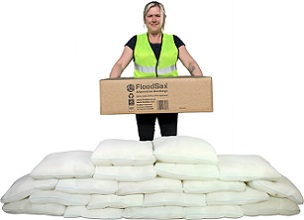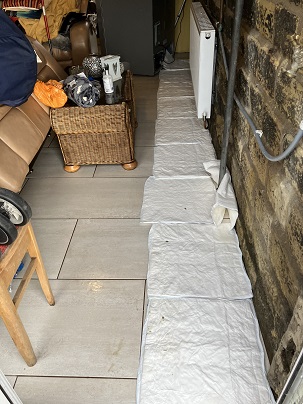 The not so great British summer with more of this on the way
The not so great British summer with more of this on the way
 All these 20 FloodSax alternative sandbags came from this one easy-to-carry box
All these 20 FloodSax alternative sandbags came from this one easy-to-carry box
 FloodSax are ideal when floodwater drips through leaky roofs and are vital for health and safety in supermarkets and other public buildings
FloodSax are ideal when floodwater drips through leaky roofs and are vital for health and safety in supermarkets and other public buildings
 FloodSax in their dry state soaking up water in this house after it leaked through the roof and ran down walls during a cloudburst
FloodSax in their dry state soaking up water in this house after it leaked through the roof and ran down walls during a cloudburst
What’s the UK weather forecast for July and August 2024 and why is the jet stream so important?
People need to prepare for flooding with yet more rain forecast to fall across the UK in the coming weeks of summer 2024.
The Met Office has revealed its long range forecast up to August 8 and is predicting more rain and unsettled weather.
This means flooding can happen anywhere, anytime and all year round with summer rain often more intense than the more persistent autumn, winter and spring rain we’ve seen over the last year.
Several places have already had their total average rainfall for July in the month’s first few days, none more so that Northolt in west London which has suffered from 66mm of rain in the first seven days of July 2024 which is approaching one-and-a-half times the normal July average.
The reason why the weather is so poor is down to the jet stream, a narrow band of fast moving air that blows from west to east five to seven miles up in the atmosphere, moving areas of high and low pressure along.
This summer the jet stream has got stuck over Greenland and the North Atlantic forming low pressures that have moved slowly across the UK, bringing unsettled weather. It spreads heat and energy from the equator to the poles and the jet stream in the northern hemisphere means cold air on the northern side and warm air to the south. If the jet stream is north of the UK we tend to see better, drier and hotter weather but if it slips down to above the UK then the weather becomes unsettled which is what’s happening now.
And that’s what the Met Office is predicting for the foreseeable future ,,, unsettled weather with the risk of rain just about anywhere as continual weather systems arrive from the Atlantic
The Met Office concludes: “There are limited, if any, signs for more prolonged settled and warm weather.”
The UK’s biggest insurance company says it’s now getting more flooding claims in summer than winter and stresses that people must be constantly prepared for flooding.
Aviva, which has 18 million customers, has revealed that more than a third of its home insurance flood claims happen between June and August … and the areas in the UK where the flooding is happening and the reasons for it differ from winter to summer too.
It means people must always be prepared for flooding and one quick and easy way is to always have a stock of FloodSax alternative sandbags as they come vacuum-packed in bags of five for space-saving storage in homes and businesses.
In winter, floods can often happen after rivers burst their banks and if the ground is too sodden it can’t cope with any more water with winter floods more common in the north west, south west and northern England.
However, the summer months see a peak in flash flood claims in Greater London, the south east and the east of England, often made worse by people paving over their gardens or laying down artificial grass. This means that a massive deluge of water from a cloudburst has nowhere to go except into people’s homes and businesses.
Jason Storah, Chief Executive of UK & Ireland General Insurance at Aviva, said: “Traditionally, we think of floods happening in the autumn and winter when rainfall occurs over a period of time and rivers reach capacity. However, this analysis shows that floods can and do occur at any time and summer flash floods are becoming more commonplace.
“This pattern of flood claims suggests that residents and businesses should be prepared for floods at any point during the year and put in place a flood action plan.
“While residents and business owners may be more aware of the risks to their properties if they are close to water, one in five properties is at risk from surface water or flash floods which can catch us off guard as they are sudden and harder to predict so we’d urge people to get ready and take action to protect their homes or businesses.”
According to Aviva, the worst month for flooding claims for both homes and businesses is traditionally December which accounts for 17% with July and August next on 12% and January fourth on 10%. The months with the least claims are April with 2.1% (despite the thought that it’s a month of showers), May on 3.5% and March on 3.6%. The other months are October (9.3%), February (8.9%), June (8.7%), November (6.7%) and September (6.5%).
In five out of the last 10 years, (2016, 2018, 2020, 2021 and 2022), Aviva received the most flood claims during the summer, with significant spikes in August 2020 and July 2021 when London was badly flooded twice in a couple of weeks.
One of the ways people can be prepared for flooding 24 hours a day and 365 days a year is to have some FloodSax alternative sandbags in their homes and businesses as they take little space to store yet are quick and easy to deploy.
One major European insurance company is now providing its customers with FloodSax in a bid to keep the flooding out and their insurance payout costs down.
The typical cost of repairing the damage in a flooded home is more than £30,000 and it’s more than double that for a commercial business.
FloodSax are multi-purpose and can be used both inside and out.
They come vacuum-packed in fives but immerse them in water and the gelling polymer inside the FloodSax absorbs and retains water so the FloodSax expands into an instant alternative sandbag that can be quickly and easily built into barriers to keep floodwater out.
In their dry state the gelling polymer inside FloodSax can soak up water dripping or leaking inside buildings to stop damage from spreading and they are used extensively like this in homes, businesses and public buildings such as supermarkets and hospitals. They are very thin with a large surface area so can be slipped underneath leaking radiators, boilers, sinks and water pipes.
Lucy Bailey from Yorkshire company Environmental Defence Systems Ltd which invented the FloodSax said: “We have now sold around three million FloodSax worldwide since 2007 and they are the original and best sandless sandbag. Local authorities have no responsibility to provide sandbags or any other flood defence device so we would echo Aviva’s advice that it’s up to people to protect their own property from flooding.”